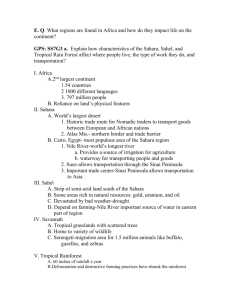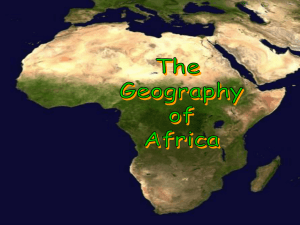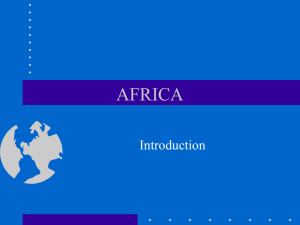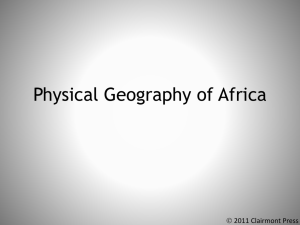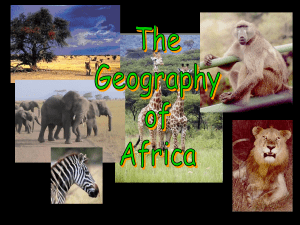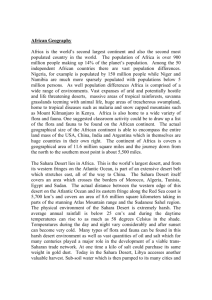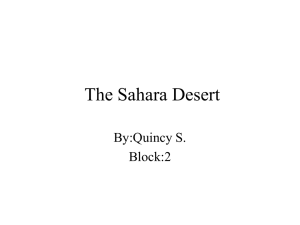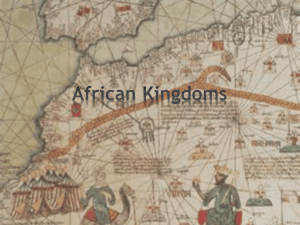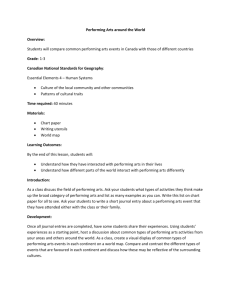Africa
advertisement
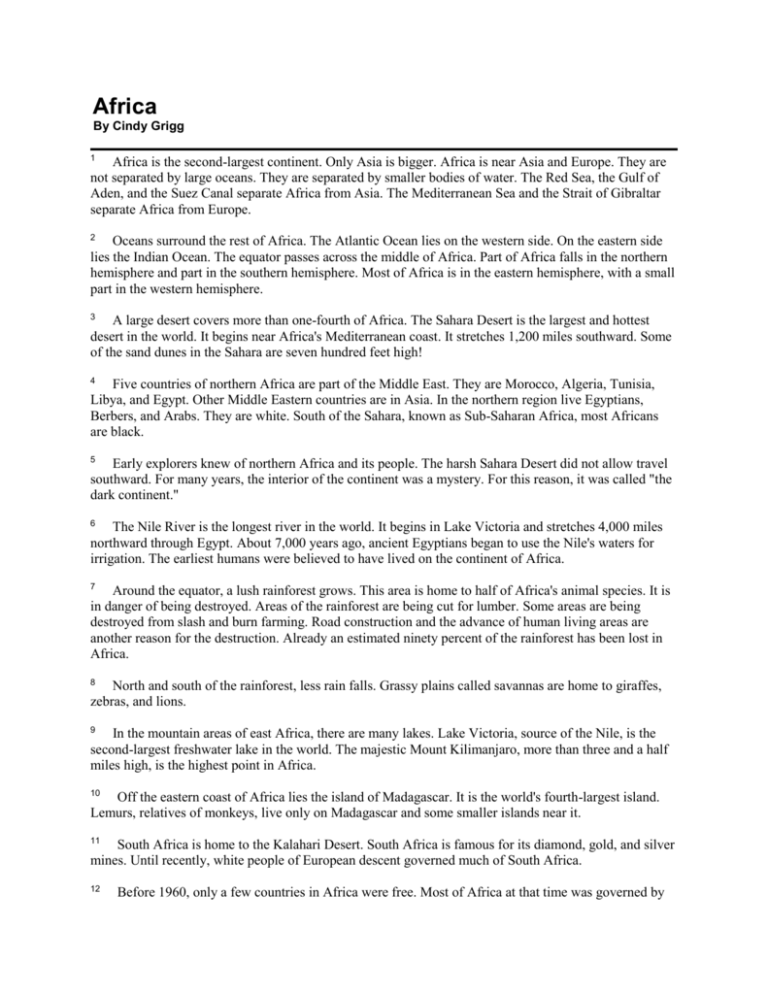
Africa By Cindy Grigg 1 Africa is the second-largest continent. Only Asia is bigger. Africa is near Asia and Europe. They are not separated by large oceans. They are separated by smaller bodies of water. The Red Sea, the Gulf of Aden, and the Suez Canal separate Africa from Asia. The Mediterranean Sea and the Strait of Gibraltar separate Africa from Europe. 2 Oceans surround the rest of Africa. The Atlantic Ocean lies on the western side. On the eastern side lies the Indian Ocean. The equator passes across the middle of Africa. Part of Africa falls in the northern hemisphere and part in the southern hemisphere. Most of Africa is in the eastern hemisphere, with a small part in the western hemisphere. 3 A large desert covers more than one-fourth of Africa. The Sahara Desert is the largest and hottest desert in the world. It begins near Africa's Mediterranean coast. It stretches 1,200 miles southward. Some of the sand dunes in the Sahara are seven hundred feet high! 4 Five countries of northern Africa are part of the Middle East. They are Morocco, Algeria, Tunisia, Libya, and Egypt. Other Middle Eastern countries are in Asia. In the northern region live Egyptians, Berbers, and Arabs. They are white. South of the Sahara, known as Sub-Saharan Africa, most Africans are black. 5 Early explorers knew of northern Africa and its people. The harsh Sahara Desert did not allow travel southward. For many years, the interior of the continent was a mystery. For this reason, it was called "the dark continent." 6 The Nile River is the longest river in the world. It begins in Lake Victoria and stretches 4,000 miles northward through Egypt. About 7,000 years ago, ancient Egyptians began to use the Nile's waters for irrigation. The earliest humans were believed to have lived on the continent of Africa. 7 Around the equator, a lush rainforest grows. This area is home to half of Africa's animal species. It is in danger of being destroyed. Areas of the rainforest are being cut for lumber. Some areas are being destroyed from slash and burn farming. Road construction and the advance of human living areas are another reason for the destruction. Already an estimated ninety percent of the rainforest has been lost in Africa. 8 North and south of the rainforest, less rain falls. Grassy plains called savannas are home to giraffes, zebras, and lions. 9 In the mountain areas of east Africa, there are many lakes. Lake Victoria, source of the Nile, is the second-largest freshwater lake in the world. The majestic Mount Kilimanjaro, more than three and a half miles high, is the highest point in Africa. 10 Off the eastern coast of Africa lies the island of Madagascar. It is the world's fourth-largest island. Lemurs, relatives of monkeys, live only on Madagascar and some smaller islands near it. 11 South Africa is home to the Kalahari Desert. South Africa is famous for its diamond, gold, and silver mines. Until recently, white people of European descent governed much of South Africa. 12 Before 1960, only a few countries in Africa were free. Most of Africa at that time was governed by Portugal, France, Belgium, and Great Britain. Africans fought many wars to be free. Since 1960, over forty independent countries have been formed in Africa. Many of these countries are poor. They are struggling to develop and provide a better way of living for their people. 13 Africa is the home to the oldest civilizations in the world. It is a continent with many rich resources and much poverty. Countries in Africa struggle with trying to provide enough food and better living conditions for their people along with saving the natural environment of their continent. Name _____________________________ Date ___________________ 1. Africa is the ______-largest continent in the world. Third Fifth Second Fourth 2. Most of Africa is in the ______ hemisphere. Northern Western Eastern Southern 3. More than one-fourth of Africa is covered by ______. Mount Kilimanjaro The Sahara Desert The Kalahari Desert Lake Victoria 4. Five countries of northern Africa are part of which region? The savanna The rainforest The Far East The Middle East 5. The part of Africa that is south of the Sahara Desert is known as ______. Sub-Saharan Africa South Africa The mountain region The lakes region 6. What is the longest river in the world? The Zaire River The Congo River The Nile River The Amazon River 7. The rainforests of Africa grow ______. Near the oceans Near the equator Near the deserts Near the mountains 8. Grassy plains, home to lions, giraffes, and zebras, are called ______. Savannas Chaparrals Taigas Boreals
